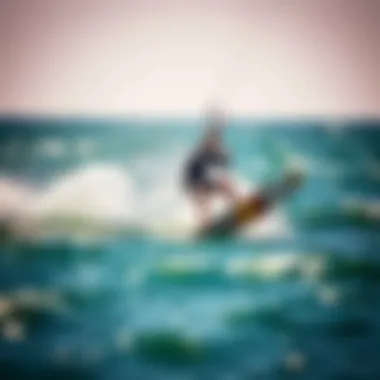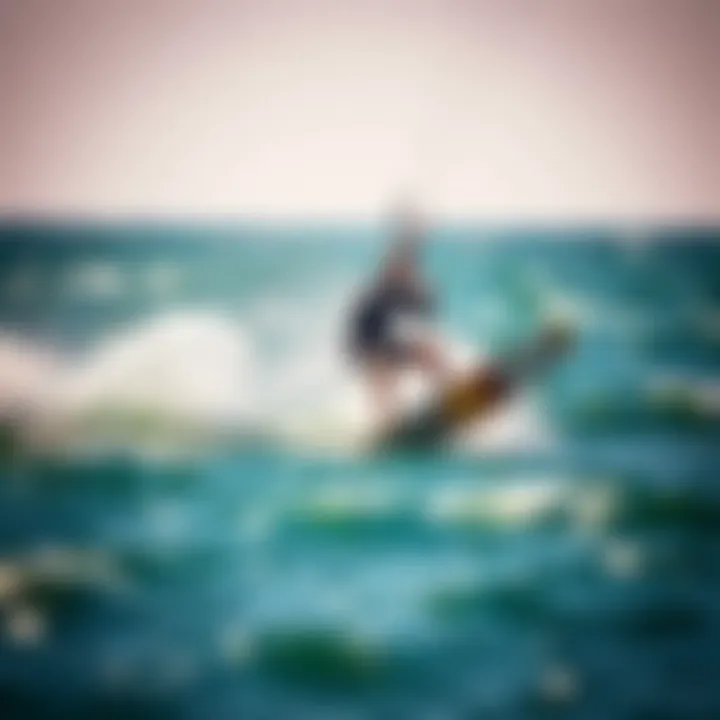Exploring Hydro Surf: Innovations in Kiteboarding


Intro
Hydro surf is making quite the splash in the kiteboarding arena, and it’s not just a passing fad. This movement symbolizes a shift towards more sustainable and performance-focused riding techniques, seamlessly blending the thrill of kiteboarding with innovative approaches that promote environmental consciousness. As we dive deeper into this phenomenon, it’s important to explore its core components: the gear, skills, and the broader implications for the sport.
Understanding hydro surf is crucial for both newcomers and seasoned riders. At its heart, hydro surfing leverages specialized gear and techniques that differentiate it from traditional kiteboarding. By utilizing hydrofoils, kiteboarders can glide above the water’s surface for a thrilling, smooth ride that minimizes drag and allows for closely controlled maneuvers.
This article aims to shed light on the principles of hydro surf, embracing its numerous benefits while also addressing concerns about the gear and skills necessary for entry. With this knowledge, enthusiasts will walk away equipped with a clearer picture of how hydro surf is changing the kiteboarding landscape.
Gear Selection
Selecting the right gear is essential for venturing into the world of hydro surf. Proper equipment not only enhances performance but also significantly impacts the rider's experience.
Types of Kites
When considering kites for hydro surf, one must look at options that prioritize versatility and adaptability. Here are a few notable types to consider:
- Foil Kites: These are lightweight and designed to fly in a wide range of wind conditions. Their ability to generate lift makes them a top choice for hydro surfing, as they can easily allow for quick ascents and stable descents.
- Wakestyle Kites: With a focus on low-end power, this kite style caters well to hydro surf, enabling riders to perform tricks with more ease and stability.
Each kite type offers unique performance properties, so testing different kites can help a rider discover what suits their style best.
Choosing the Right Board
Picking out the right board is just as critical. Hydro surf boards typically come in two main varieties:
- Foil Boards: These boards feature a foiled structure allowing the rider to lift above the water. They reduce drag and provide a more fluid ride.
- Surfboards: Traditional surfboards can also be adapted for hydro surf, particularly when outfitted with a hydrofoil setup. These boards tend to offer a more familiar experience for those transitioning from regular surf to hydro surf.
When selecting your board, consider factors like weight, volume, width, and personal riding style. A well-matched board enhances not only comfort but control while riding.
By paying attention to the selection of kites and boards, riders can maximize their hydro surf experience. Proper gear lays the foundation for further skill development, leading riders towards mastering hydro surf techniques and beyond.
Skill Development
Developing the necessary skills for hydro surf is a gradual process, one that requires practice and patience.
Essential Techniques
In hydro surf, understanding the essentials paves the way for bigger achievements:
- Kite Control: Proficient kite handling contributes significantly to a smooth ride. Mastering the nuances of powering up and down will help in navigating varying conditions.
- Riding Position: Keeping a low center of gravity while maintaining a steady stance can make a world of difference. This balance is essential for harnessing the power of the kite effectively.
Progression Tips
To progress, consider the following:
- Start Small: Begin practicing on calm days, gradually moving to more challenging conditions as confidence builds.
- Seek Feedback: Engage with fellow riders or instructors to gain insight and tips. Observation can lead to quicker improvements.
In summary, hydro surf in kiteboarding represents a blend of innovative techniques and environmental awareness. By choosing the right gear and focusing on skill development, riders can dive into this exhilarating new frontier of the sport.
For more resources on gear options or to connect with other enthusiasts, check out Wikipedia's kiteboarding page, and for ongoing discussions, visit Reddit’s kiteboarding subreddit. Calling on the expertise of seasoned instructors may very well accelerate one’s growth in this thrilling sport.
Understanding Hydro Surf
Hydro surf is not just a fleeting trend within the realm of kiteboarding; it represents a fundamental shift in how enthusiasts approach the water, integrating technology and technique in novel ways. As this sport evolves, understanding hydro surf becomes critical for both seasoned kiteboarders and newcomers alike. It provides a myriad of benefits, from enhancing performance to reducing environmental impact. Furthermore, grasping the intricacies of hydro surf allows participants to appreciate the engagement between the sport and ecological considerations.
Definition and Background
Hydro surf can be defined as a form of kiteboarding that leverages hydrofoils to lift riders above the water's surface. This creates a unique sensation of gliding over the waves, offering a combination of speed and agility that traditional kiteboarding often lacks. The concept emerged from the desire to harness the wind and water in unprecedented ways, leading to smoother rides in various conditions.
The origins of hydro surf may be traced back to the innovations in hydrofoil design and its application in kiteboarding. Early enthusiasts began experimenting with different configurations, evolving from merely riding the surface to skillfully cutting through air and water. This development was a game changer, as it opened intersesting possibilities for both recreational and competitive kiteboarding.
The Evolution of Hydro Surf


The evolution of hydro surf is a fascinating journey through technological advancements and creative experimentation. Initially, hydrofoiling was an elite niche, reserved for those able to access specialized equipment. However, as more brands like Naish and Slingshot entered the market, production and design went into overdrive. This commercialization allowed a wider audience to tap into hydro surf.
The sport's development has also seen a marked shift in technique. Where once just the act of staying upright was an accomplishment, today's hydro surfers execute incredible maneuvers, blending old-school kiteboarding tricks with the new dynamics provided by foils. Tricks that were once impossible on the water, like a double backflip, can now be seen against the backdrop of a sunset, with riders soaring through the air with elegance and ease.
A pivotal moment in hydro surf history was the introduction of adjustable foils, which allowed users to tailor the ride to their comfort level and skill set. This adaptability has made hydro surf more accessible to various skill levels, breaking down barriers in the community and encouraging lessons and workshops.
In summary, understanding hydro surf is essential for anyone involved in kiteboarding. It encapsulates both the artistry and technical elements of the sport, pointing to the future of what is possible on the water. The interplay between the essence of kiteboarding and the innovations that hydro surf represents marks an exciting chapter in this aquatic adventure. Each enthusiast, be it a beginner or an instructor, has a stake in how this evolution unfolds, making the investigation of hydro surf a timely endeavor.
The Mechanics of Hydro Surfing
Understanding the mechanics of hydro surfing is key to mastering this exhilarating facet of kiteboarding. As kiteboarding enthusiasts explore the nuances of hydro surf, they will uncover how factors such as water dynamics, equipment design, and rider technique converge to create a unique experience on the water. Not only does this understanding enhance performance, but it also enriches the ability to appreciate the beauty and complexity of the sport as it continues to evolve.
How Hydro Surf Works
Hydro surfing operates at the intersection of hydrodynamics and kitesurfing. The principle involves employing a hydrofoil board that elevates off the water’s surface, which reduces drag, allowing the rider to navigate with less effort. This is achieved through a finely tuned balance of speed, angle, and weight shift.
When the kite is powered properly, it generates lift and propulsion, similar to how an airplane wing functions in the air. Here’s a simplified breakdown of how this all comes together:
- Lift and Drag: The hydrofoil’s wings create lift as they move through the water. This lift increases with speed, making later turns seamless and more energy-efficient.
- Pressure Distribution: The design of the hydrofoil directs water flow in a way that stabilizes the board, enhancing control and responsiveness during maneuvers.
- Rider Dynamics: A rider's shifting body weight plays a crucial role in maintaining equilibrium on the board. Leaning back can enhance speed, while leaning forward can assist in maneuverability.
Ultimately, the goal is to thrill while navigating the canvas of water beneath your board, experiencing both speed and fluidity. A deep comprehension of these functioning elements empowers riders to elevate their skills and relish the experience fully.
Physics Involved in Hydro Surfing
The physics behind hydro surfing might sound intimidating, but understanding the fundamental concepts can greatly enhance a rider’s skills. Here are a few principles that underpin this surfing style:
- Buoyancy and Density: Hydrofoils depend on the buoyancy to lift the board out of the water. The design must consider the density of water to ensure efficient elevation.
- Bernoulli's Principle: As the board moves, the wings of the foil create different air pressures. Lower pressure above the wing and higher pressure below creates lift, pulling the hydrofoil upwards.
- Drag Forces: Minimizing drag is critical. Every movement must be deliberate to ensure that excess energy isn't wasted, allowing for longer rides without excessive fatigue.
In practical terms, these physics concepts translate to improved technique on the water. Riders who harness this knowledge can refine their skills and even outperform expectations in varied conditions.
"Understanding the mechanics and physics behind hydro surfing not only boosts performance but also connects the rider to the very essence of the sport."
By breaking down these elements, kiteboarders can foster a deeper appreciation for hydro surfing beyond just an adrenaline rush. They can view it through the lens of science and technique, which makes experiences richer and more fulfilling.
Gear Essentials for Hydro Surf
In the realm of hydro surf, the right equipment plays a pivotal role in the enjoyment and safety of the experience. First and foremost, choosing the right gear not only enhances performance but also ensures that riders can handle the varying conditions encountered on the water. This section unveils the essential components every hydro surfer should consider, which can greatly impact their overall success and satisfaction in the sport.
Selecting the Appropriate Board
When embarking on the hydro surf journey, one cannot overstate the importance of selecting the appropriate board. Hydro surf boards are distinct, designed to provide buoyancy and maneuverability. These boards are typically shorter and wider, enabling better planing on the water surface.
- Material Matters: Most hydro boards are made from lightweight materials such as epoxy or carbon, allowing for easier handling and quicker turns.
- Board Shape: The shape of the board impacts how it interacts with the water. A flatter bottom provides speed while a slight rocker helps with turning. Consider your skill level and preference—some might like a sleek design while others may favor a more stable build.
- Test Drive Before You Buy: If possible, it's wise to try different boards. Renting or borrowing boards from local kiteboarding communities can help you find the best fit.
Kite Specifications for Hydro Surfing
The kite is another critical element of hydro surf. As the source of power, the specifications of the kite heavily influence your ride.
- Size and Type: Choose a kite that matches the wind conditions you expect. A smaller kite is more manageable in strong winds, while a larger kite provides more lift in lighter winds.
- Material Performance: Kites made from durable yet lightweight materials allow for better responsiveness and control. Look for kites with reinforced seams and ripstop fabrics, which can endure the wear and tear of hydro surfing.
- Bar and Lines: Don't overlook the bar and line setup. A reliable control bar with suitable line lengths can make a noticeable difference, enabling precise adjustments as you navigate the water.
Safety Gear Considerations
Hydro surfing, while exhilarating, comes with risks. The right safety gear can make all the difference in ensuring a safe ride.
- Impact Vest: Investing in an impact vest is essential. These vests provide both flotation and protection against accidental falls or collisions with the board.
- Helmet: A good-quality helmet is a must, especially for beginners. It helps shield against head injuries in case of unexpected falls.
- Leashes: A reliable board leash is crucial. It will keep your board close to you and prevent it from drifting away after a fall.
- Personal Flotation Device (PFD): Depending on your location, a PFD may be required, but even if it isn't, it's wise to wear one. A PFD enhances safety and promotes confidence in challenging conditions.
Remember: Always check local regulations and recommendations when selecting safety gear.
In summary, gearing up for hydro surf involves more than just picking what's trendy. It's about understanding how each piece works together to enhance your performance while keeping your safety at the forefront. Selecting the right board, kite, and safety equipment not only tailors your experience but also opens up new possibilities on the water.
Techniques for Successful Hydro Surfing
When it comes to hydro surfing, mastering the right techniques can make all the difference. Understanding the pivotal skills that help riders maneuver through the water can elevate one’s experience from basic to extraordinary. This section will explore those fundamental skills that are essential for beginners and expand into advanced techniques for seasoned kiteboarders looking to push their boundaries in hydro surf.


Fundamental Skills
Before hitting the water, you need to lay a solid foundation of fundamental skills. These basic techniques aren’t just for show; they enable you to maintain control, balance, and ultimately enjoy the ride.
- Stance and Balance: The first step to successful hydro surfing is establishing the right stance. Keep your feet shoulder-width apart, with your knees slightly bent. This lowers your center of gravity and helps with balance as you ride atop the hydrofoil. Remember, feeling comfortable in your stance will allow you to react swiftly to changes in water conditions.
- Kite Control: Learning to fly your kite is a crucial part of the process. A well-flown kite can generate lift and power, essential for taking off and maintaining speed while hydro surfing. Practice steering the kite smoothly, learning how to generate power without over-pulling the lines, leading to a more seamless ride.
- Board Maneuvering: Getting used to the board is another key element. Begin by practicing simple movements like edging, which involves tilting the board on its edges to steer. This will also aid in gaining speed as you’ll feel the water interaction with the board.
- Water Start: Mastering the water start is often the rite of passage for aspiring hydro surfers. Start in a seated position with your kite in the right angle and gradually push yourself upright. Once you catch the right pull, pivoting your board can help you glide onboard smoothly.
"A strong foundation allows you to take on more demanding techniques later on. No rush; it’s all about the ride."
These fundamental skills provide the cornerstones upon which every hydro surfer can build. By honing these basics, you’ll find it easier to transition into advanced techniques that push you even further.
Advanced Techniques
Once you’re comfortable with the fundamental skills, diving into advanced techniques brings a whole new level of thrill and excitement. Although challenging, these maneuvers can tremendously enhance your performance in hydro surf.
- Jumping and Tricks: To perform jumps, timing is all in the kite control. Pull down on the back hand to load the kite while bending your knees, then, when you’re ready, release and rise into the air. The key here is to settle slightly into the water when you land to maintain balance. Once you gain confidence, start adding in trick combinations like backflips or spins.
- Footswitching: Switching your feet mid-ride enables you to perform tricks and change direction without losing momentum. It may take some practice, but once you get the footswitch down, the whole ride opens up: you can seamlessly maneuver in a fluid motion, enhancing your performance.
- Riding Switch: The switch stance riding gives you a chance to surf with your opposite foot forward. It not only challenges your skills but also works on your overall balance and control. Start slow and work your way up to longer distances.
- Tacks and Jibes: Mastering tacks involves switching direction while maintaining speed without losing too much momentum. Jibes let you turn while still facing the same direction; they’re useful for changing course quickly.
With continued practice, these advanced techniques can help you attain a level of mastery where the water and air become a fluid extension of your movements, allowing for creativity and style in your hydro surfing journey. The amalgamation of these skills and techniques ultimately propels you to become a more proficient hydro surfer, ready to seize the waves with finesse.
Hydro Surfing Destinations
Hydro surfing is not just about the gear or the techniques; the location can make or break your experience on the water. Choosing the right spot for hydro surf is akin to picking a fine wine to complement a gourmet meal; it enhances the overall experience and brings out the best of both the sport and the setting. Ideal destinations provide specific wind and water conditions that are crucial for this exciting kiteboarding style. Mistakes in selection can lead to frustration and unsafe situations, underscoring the vital role of the right environment.
Ideal Locations for Hydro Surfing
When it comes to finding the perfect hydro surf location, a few key elements come into play:
- Water Conditions: Flat water is often preferred, with some riders enjoying light chop for a bit more thrill. Locations such as lakes or shallow coastal areas can provide the ideal surface.
- Wind Consistency: The wind needs to blow steadily. Locations near coastal areas that aren’t too gusty are often the best.
- Accessibility: An easily reachable place with suitable parking and amenities can enhance your adventure.
These factors come together beautifully at places like Hood River in Oregon, known for its steady winds and diverse water types, or the stunning beaches of Tarifa in Spain, which offer consistent conditions during the summer months.
Global Hotspots: An Overview
The globe is peppered with destinations that stand out for hydro surfing, often favored by the kiteboarding community for various reasons. Here are a few noteworthy hotspots:
- Maui, Hawaii: This island isn’t just known for its breathtaking scenery; it boasts consistent winds and warm waters, making it a paradise for those wanting to hit the hydro surf.
- Cape Town, South Africa: A mecca for water sports enthusiasts, the waters here can be challenging yet incredibly rewarding with majestic mountain backdrops.
- Costa Brava, Spain: With its picturesque landscapes and reliable wind patterns, it invites kiteboarders from all over the world to experience hydro surf.
- Bonaire, Caribbean: Known for its crystal-clear waters and steady winds, this island has become a favorite for many travelers looking for a tropical adventure.
"Choosing the right destination can transform an ordinary surf experience into an extraordinary adventure."
In summary, understanding and selecting hydro surfing destinations is essential for kiteboarding enthusiasts and professionals alike. Awareness of location pros and cons, coupled with a sense of adventure, can lead to unforgettable sessions on the water.
Safety Protocols in Hydro Surf
Safety is of paramount importance in any water sport, and hydro surf is no exception. With the thrill of gliding across the water, feeling the wind in your hair, and the adrenaline coursing through your veins, it can be easy to overlook potential hazards. However, taking the time to understand and respect safety protocols can mean the difference between a fun day out and a serious incident.
Environmental Factors
In hydro surf, one must be acutely aware of environmental factors that can affect safety. Understanding wind patterns, water currents, and weather conditions is crucial.
- Wind Conditions: Wind is the lifeblood of kiteboarding. However, winds can shift unexpectedly, leading to difficult conditions. Before launching, be sure to check local forecasts. Even experienced riders can find challenging surprises when wind speeds are inconsistent.
- Water Currents: Knowing the waterway can make all the difference. Strong currents can lead to fatigue or disorientation and can also affect kite control. Research local waterways, particularly if you're venturing into less familiar territory.
- Water Temperature and Conditions: The temperature can fluctuate significantly based on the season and location. Wear appropriate safety gear such as wetsuits or impact vests. Hypothermia can set in faster than you might think, even in seemingly comfortable waters.
- Marine Life Awareness: Being aware of marine life in your chosen location can help avoid unwanted encounters. Check local advisories regarding jellyfish seasons or sea urchin habitats. Always respect the environment, as interactions can range from inconvenient to dangerous.
In light of these factors, kiteboarders should adopt practices that address local conditions effectively. Ignoring the environmental context can not only lead to personal injury but can also disrupt local ecosystems.
On-Water Safety Practices
Once on the water, specific practices can enhance safety while allowing riders to enjoy their experience fully.
- Buddy System: Never ride alone. Having a partner can help in emergencies, whether it’s dealing with equipment failure or navigating an unexpected situation. Use hand signals to communicate while you're out there!
- Pre-ride Checkups: Regularly inspect your gear before heading out. Check your kite's lines, the pump’s reliability, and overall equipment integrity. A well-kept piece of gear is crucial for safety and performance.
- Emergency Protocols: Be aware of how to handle situations such as going downwind or being pulled by a current. Knowing your escape routes can be lifesaving. Always carry a whistle or signaling device in your gear, so that you can alert others if you're in trouble.
- Staying Informed: Be mindful of other water users, including boats, swimmers, and fellow surfers. Maintain a safe distance to minimize accidents. Familiarize yourself with local rules and etiquette—some areas have specific places designated for kiting.
"Safety doesn't happen by accident. It’s a mindset. Prior preparation prevents poor performance."
By recognizing both environmental influences and executing robust on-water safety measures, hydro surfers can significantly mitigate risks. Emphasizing safety not only protects the individual but contributes to the overall vibrancy of the sport, ensuring future generations can enjoy the beauty and thrill of hydro surf.


For more information on safety guidelines and best practices, consult resources like The American Kiteboarding Association or Kiteboarding Australia. Both offer detailed advice tailored to the sport.
Environmental Considerations
Understanding the environmental elements connected with hydro surf is more crucial than ever in today’s world. The practice doesn't just involve the thrill of catching waves and cruising across the water, it also comes with responsibilities toward nature. It's about finding that sweet spot where enjoyment meets sustainability. The rise of hydro surf in kiteboarding opens up discussions around ecosystems and how we can partake in this sport while minimizing our impact on them.
Impact of Hydro Surf on Ecosystems
Engaging in hydro surf isn’t just about enjoying the ride; it has profound implications on the ecosystems where we choose to practice. Disturbances occur when we create wake patterns or alter coastal shapes with our boards and kites.
- Habitats at Risk: Kiteboarding can disturb local wildlife, especially in sensitive areas like bird nesting sites and coral reefs. Fish populations may dwindle in regions where hydro surfers bustle.
- Water Quality: Hydro surf may also introduce pollutants into water systems, caused by gear wear or human activity. This pollution can lead to harmful algal blooms, adversely affecting marine life. The resulting toxins could be detrimental not just to aquatic animals but also to those who consume seafood and drink local water.
- Propeller Effects: The increased foot traffic and movement in marine environments can disrupt natural behaviors of aquatic creatures. A simple change in where we ride could mean a lot for local ecosystems.
In light of these points, it’s imperative that riders align their practices with environmental mindfulness.
Sustainable Practices in Hydro Surfing
Integrating sustainable practices into hydro surf can significantly mitigate its environmental footprint. Here’s how enthusiasts can contribute positively:
- Eco-Friendly Gear: Look for boards made from recycled materials or bio-resins. This not only reduces waste but also supports brands that prioritize sustainability.
- Stay Informed: Know about local wildlife and their mating seasons to avoid practicing in sensitive areas during these times. Always check where to launch and land your kite without infringing on marine habitats.
- Leave No Trace: Practicing the fundamentals of clean outdoor activities can go a long way. Picking up after yourself, minimizing waste, and being thoughtful about where you ride can leave spots as pristine as you found them.
- Community Engagement: Get involved in local beach cleanups or conservation efforts. More often than not, kiteboarders can be found in the same places where conservation work is most needed. Building relationships with local ecologists can also educate everyone on best practices.
"The ocean is our playground, but it’s also our responsibility. Keeping it clean ensures we can enjoy it for generations to come."
With the adoption of these practices, hydro surfing can become not just an exhilarating sport but also a peaceful coexistence with nature. In essence, this approach can lead to a rich experience that respects and preserves the beauty of the world we ride through. By considering environmental implications, we can cultivate a community that values sustainable adventure, ensuring future generations can share in the joys of hydro surf.
The Future of Hydro Surf within Kiteboarding
The horizon of kiteboarding is rapidly changing, particularly with the advent of hydro surf. As enthusiasts and professionals alike take notice, the unique marriage of these two activities presents not only thrilling experiences but also new waves of possibilities. Understanding the significance of hydro surf within the kiteboarding spectrum is crucial—more than just a trend, it offers benefits and considerations that demand our attention.
Emerging Trends and Innovations
For anyone keeping an ear to the ground, it's clear that the innovations in hydro surf are making waves—literally and figuratively. Kiteboarding technology has taken a leap forward, ensuring that hydro surf is accessible and enjoyable for a broader audience. This includes lighter, more buoyant boards designed specifically for hydrofoil enhancements, allowing for a smoother ride on water with less energy expenditure.
Another exciting trend is the convergence of artistry and technology in gear design. Kiteboard manufacturers are experimenting with materials and shapes that improve performance while being lighter. For example, boards that were once uniform in shape are now being crafted with an array deck designs that optimize aerodynamics and stability. Moreover, kites with flexible frames offer quicker responses to rider movements, enhancing the overall experience.
Hydro surf is also pushing the envelope regarding community engagement. More established kiteboarding schools are now incorporating hydro surf specific courses. This is not only educating aspiring riders but also gathering a community of enthusiasts who are eager to share tips and adventures.
"The evolution of hydro surf can be likened to a phoenix rising; while kiteboarding traditions remain, new techniques and technologies create an exhilarating resurgence of interest."
Community and Cultural Implications
The integration of hydro surf into kiteboarding is more than just a physical activity; it shapes social environments and relationships within the sport. With clubs forming around this niche, riders often share not only their skills but also their experiences and cultures. This creates a diverse melting pot of ideas, fostering friendships that transcend borders.
The rise of hydro surf has also fostered inclusivity within the community. The gear is often designed with varying skill levels in mind, making it more approachable for those who might find traditional kiteboarding daunting. As more people from different backgrounds join, the narrative of kiteboarding becomes richer and broader.
Conversely, some purists might view hydro surf as a deviation from traditional kiteboarding principles. However, this tension can fuel discussions that promote respect for both forms, ultimately enriching the kiteboarding culture as a whole. The challenge will be ensuring that this emerging trend does not overshadow the foundational aspects that many hold dear.
In summary, the future of hydro surf in kiteboarding is bright and multifaceted. With emerging trends centered on innovation and community, the trajectory of this sport invites both excitement and consideration. As those interested continue to explore this intertwining of disciplines, adapting to changes while honoring traditions will be key to preserving the essence of kiteboarding.
Closure
In wrapping up our exploration of hydro surf, it’s vital to underscore the topic’s significance in the broader context of kiteboarding. As we have traversed through the various facets of hydro surf, it becomes clear that this innovative practice is not just a fleeting trend; it represents the evolution of the sport itself.
Here are some crucial elements that stand out:
- Integration of Technology: The advancements in gear and designs that cater specifically to hydro surf are numerous. From specialized boards that enhance buoyancy to kites that offer precision control, technology plays a pivotal role in this sport.
- Environmental Awareness: As kiteboarding enthusiasts embrace hydro surf, there’s an increasing consciousness about environmental impact. This awareness drives discussions around sustainable practices, ensuring that the beauty of the natural world remains intact for future generations of surfers.
- Community Engagement: Hydro surf fosters community among kiteboarders. As more riders venture into this new territory, they share experiences, techniques, and tips that enrich the collective knowledge base, thereby nurturing a vibrant culture within the sport.
While hydro surf propels kiteboarding into novel territory, it also beckons a responsibility to uphold safety and eco-friendliness. Understanding these aspects is essential for anyone keen to engage with this emerging trend. This section serves as a reminder that while we chase thrills, we also must heed both our limits and the environment's fragility.
Key Takeaways
- Hydro surf is a growing trend within kiteboarding that enhances the sport’s diversity.
- Utilizing advanced technology is crucial for improving performance and safety in hydro surf.
- The sport encourages environmental stewardship and responsibly engaging with nature.
- Building community connections is a vital aspect of embracing hydro surf.
Inviting Further Exploration
The journey into hydro surf doesn’t end here. For those looking to dive deeper into the practice, consider participating in local hydro surf meet-ups or workshops. Engaging with experienced riders can provide invaluable insights and enhance your skill set.
Additionally, keep an eye on resources such as Reddit for discussions primarily focused on the latest in hydro surf. Local shops that specialize in kiteboarding gear may also host seminars or demo days that invite enthusiasts to experience the latest innovations firsthand. This is an opportunity not just to learn, but also to connect with likeminded individuals in the kiteboarding community.
In essence, whether you’re a seasoned kiteboarder or a curious newcomer, there is always an avenue for growth and exploration in the realm of hydro surf. Embrace the challenge and be part of an exhilarating chapter in the kiteboarding narrative.















